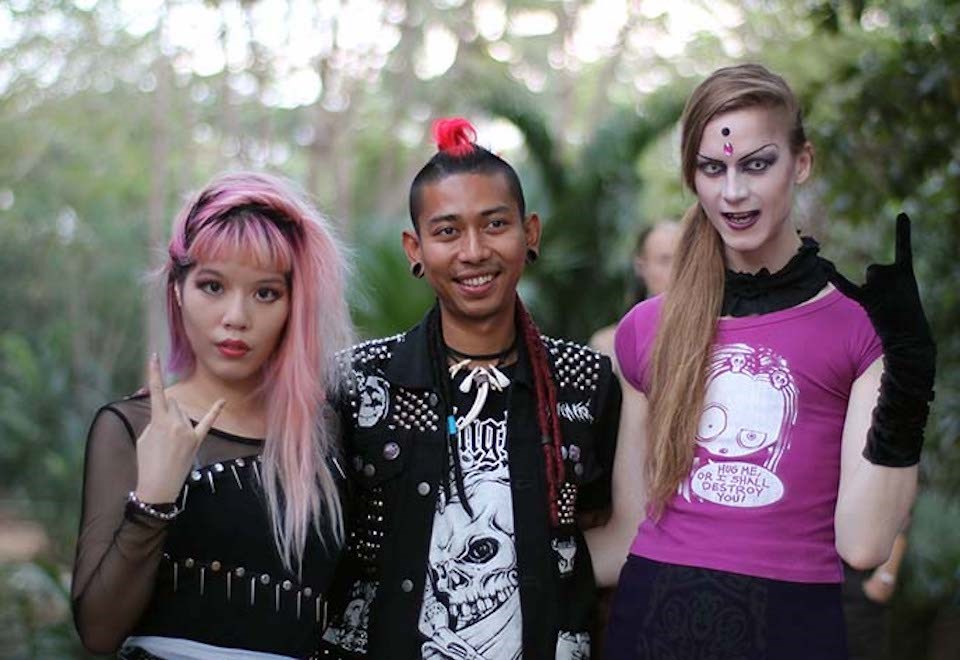"I like to say I'm a friend of Satan. I don't like to put labels on myself," says .
The Vancouver-based travel and culture blogger's pull toward alternative subcultures has taken her all around the world, seeking stories from people whose passions have also taken them off the beaten path.
Her book, The Little Book of Satanism, was released in October 2022 and discusses the long history of Satanic worship and misconceptions about who modern Satanists are.
Gravitating toward Gothic culture from an early age, La Carmina loved checking out alternative stores on Granville Street and attending concerts. When blogging became popular in the 2000s, she was eager to share her passion for niche topics with people around the world.
"These were the very early days of social media. We only had MySpace. I latched onto it," she told V.I.A. "Because I was an early adopter [of blogging] that led to a lot of really cool opportunities from the start."
La Carmina's journey from blogging to world traveller
In the beginning, the fashionista mainly blogged about Japanese trends and subcultures, including the popular Harajuku style. But her scope broadened as she explored other cultures around the world.
With over 70 countries visited under her belt, the culture connoisseur continues to seek out non-traditional travel experiences, including LGBTQIA2S+, goth, punk, and underground fashion trends. Her travels have found her dancing with drag queens in Israel, rocking with punks in Myanmar (formerly Burma), and popping into Hobbit holes in New Zealand.
"It's so interesting because in a place in the Middle East or Myanmar, maybe India, sometimes you find these alternative expressions and they somehow coexist within a culture that [sometimes people in the West think] as being repressive and whatnot. When you actually go there and meet the people you realize it's not so simple," she explained.
La Carmina offers the punks of Myanmar as a great example. "The punks there are very hardcore 70s, 90s-style hardcore punks with DIY outfits and mohawks," she describes, but notes they also often practice Buddhism. They help feed the homeless while they don their hardcore attire, compelled to help people who may be enduring situations they've also faced.
Similarly, drag queens in the Middle East and the third gender in India face cultural persecution but continue to "speak their truths," all of which, La Carmina explains, motivates her to continue seeing the world.
One of her next stops might be Romania, where she will help arrange a shoot for a TV show about body modifications and suspension. Body suspension involves piercing a person's skin with hooks and temporarily suspending them.

La Carmina says there is a "real passion for visual personal expression" in Japan. While Northern American goths tend to favour dark clothing, fishnets, and spike accessories, it isn't uncommon to see Japanese goths rocking full Victorian gowns, compete with parasols. Other people look like creatures from outer space, with intricate costumes featuring a flourish of bright colours."
Why Satanism?
While Satan worship may conjure up images of several negative stereotypes, La Carmina explains that most modern practitioners don't even believe in the Antichrist. That would mean believing in the Christian god, and most of them are atheists.
There isn't a "one size fits all" approach to Satanism, either, according to the blogger. While the majority of people who consider themselves Satanists do not believe in a deity, many of them do.
La Carmina's book, which focuses on the non-theistic approach, discusses how practitioners see "Satan [as] a metaphor for someone who stands up against authority and the oppressor; someone who's willing to ask questions and forge their own path."
In contrast to some religions, Satanism encourages individualism and independent thinking. The belief system is often popular with people who grew up being told they were sinners or "not good people."
Marginalized people throughout history were often deemed Satanists, not unlike women during the Salem Witch Trials. In the modern era, many people who consider themselves Satanists fight for the rights of persecuted groups, such as LGBTQIA2S+, and other groups that are targeted for their beliefs or practices.
Satanism in Vancouver
The Satanic Temple (TST) has a congregation in Â鶹´«Ã½Ó³»with in-person meetings. On its , it states that its mission is to "encourage benevolence and empathy among all people, reject tyrannical authority, advocate practical common sense, oppose injustice, and undertake noble pursuits."
Some TST members are Jews or Buddhists since being a practitioner doesn't forbid such things. The church states, however, that a person's beliefs should stem from a "scientific understanding of the world" and that they shouldn't have to distort reality to support them.
TST is often confused with The Church of Satan, which was founded by Anton Szandor LaVey in the 1960s. Each group has a significantly different approach, which has led to confusion over the years.
While there are Satanists around the world, ones with larger Christian demographics tend to have a dramatically different approach to the religion. But calling out hypocrisy in other religions is only a part of what it means to be a Satanist, according to La Carmina.
Satanists in Â鶹´«Ã½Ó³»and across the globe will use symbols, such as the inverted pentagram--an upside-down, five-pointed star--as well as the number 666. These items are found in jewellery, tattoos, goth clothing, and more. TST practitioners say these symbols "embody shock or blasphemy, as well as a declaration of their personal independence from superstition," La Carmina explains in her book.
What's next for La Carmina?
La Carmina will appear as a contestant on a new CTV game show hosted by Lily Singh called Battle of the Generations, which airs July 31, at 9 p.m. Each contestant on the show plays under their respective age demographic, and she will represent millennials, with three other people covering boomers, Gen Zs, and Gen Xs.
Follow the Â鶹´«Ã½Ó³»blogger's .




